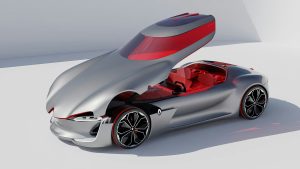3D-Printed Cars: The Future of Affordable, Sustainable Manufacturing
As technology continues to advance, 3D printing has emerged as a game-changing manufacturing method. This innovative technology allows for the creation of three-dimensional objects by adding layer upon layer of material. While 3D printing has been used in various industries such as healthcare and aerospace, it is now making its mark in the automotive industry. In recent years, 3D-printed cars have been gaining attention as the future of affordable, sustainable manufacturing. Let’s explore how these futuristic cars are changing the game for the automotive industry.
The Rise of 3D-Printed Cars
The first 3D-printed car, known as the Strati, was unveiled in 2014 by Arizona-based company, Local Motors. It was a two-seater, electric vehicle that was made from only 40 components, as opposed to the thousands of parts used in traditional cars. The Strati was created using a large-scale 3D printer, reducing production time to just 44 hours. This feat broke records and opened up a new realm of possibilities for the automotive industry.
Since then, other companies such as Divergent 3D and XEV have also joined the race in 3D printing cars. XEV, a Chinese-Italian company, created LSEV, an electric car that is made from only 57 parts, drastically reducing manufacturing time and costs. Divergent 3D introduced the Blade, a supercar that is 3D printed using aerospace-grade carbon fiber and can go from 0-60mph in just 2.2 seconds. These companies are showing that 3D-printed cars are not just futuristic concepts, but a reality that is slowly but surely becoming more mainstream.
The Benefits of 3D-Printed Cars
Affordability
One of the major benefits of 3D-printed cars is the cost savings. Traditional car manufacturing requires expensive tooling and molds, as well as labor-intensive assembly processes. With 3D printing, these costs are significantly reduced as the parts can be made directly from a digital design, eliminating the need for tooling. Moreover, the use of lightweight materials in 3D-printed cars can also reduce the cost of production and maintenance.
Sustainability
The use of 3D printing in car manufacturing also has a positive impact on the environment. Traditional car manufacturing produces a significant amount of waste, as materials are often cut, shaped, and assembled to fit the design. With 3D printing, only the necessary amount of material is used, leaving minimal waste behind. Additionally, 3D printing allows for the use of eco-friendly materials such as bioplastics, further reducing the environmental impact of car production.
Customization
One of the most appealing aspects of 3D-printed cars is the ability to customize designs. With traditional manufacturing, large production runs limit the ability to personalize vehicles. However, with 3D printing, each car can be made to order, allowing for unique designs and features tailored to the customer’s preferences. This also opens up opportunities for customization in the aftermarket, providing a new market for car manufacturers.
The Future of 3D-Printed Cars
The potential for 3D-printed cars is vast and has the potential to revolutionize the automotive industry in the coming years. As technology continues to improve, we can expect to see more companies adopting 3D printing in their manufacturing processes. It is estimated that by 2027, 3D-printed cars will make up 10% of global light passenger vehicle production. Furthermore, advancements in 3D printing technology could eventually lead to the production of fully functional, autonomous 3D-printed cars that are capable of driving on roads.
However, challenges still remain for the widespread adoption of 3D-printed cars, such as regulatory hurdles and limited material compatibility. But with the continuous development and innovation in this technology, these challenges are expected to be overcome in the near future.
Conclusion
3D-printed cars are proving to be game-changers in the automotive industry. They offer affordability, sustainability, and customization, making them a highly attractive option for car manufacturers and consumers alike. As this technology continues to evolve, we can expect to see more innovative and sustainable cars hitting the roads, changing the landscape of the automotive industry for the better.











